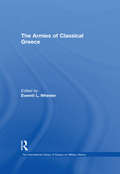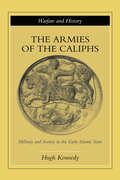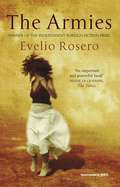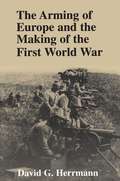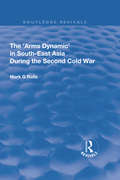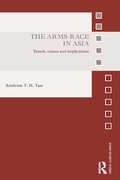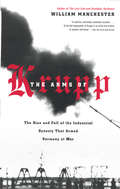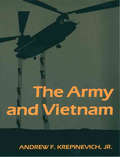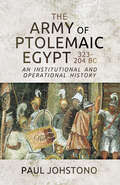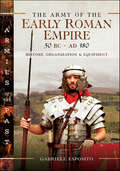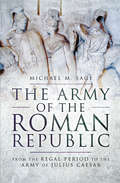- Table View
- List View
The Armies of Classical Greece (The International Library of Essays on Military History)
by Everett L. WheelerThe origin of the Western military tradition in Greece 750-362 BC is fraught with controversies, such as the date and nature of the phalanx, the role of agricultural destruction and the existence of rules and ritualistic practices. This volume collects papers significant for specific points in debates or theoretical value in shaping and critiquing controversial viewpoints. An introduction offers a critical analysis of recent trends in ancient military history and provides a bibliographical essay contextualizing the papers within the framework of debates with a guide to further reading.
The Armies of Europe
by Edor von KöppenA fascinating glimpse into the history of warfare. A must for military history buffs, writers wishing to for historical accuracy in their portrayal of historical armies, or anyone interested in the eighteen hundreds.
The Armies of the Caliphs: Military and Society in the Early Islamic State (Warfare and History)
by Hugh KennedyThe Armies of the Caliphs is the first major study of the relationship between army and society in the early Islamic period, and reveals the pivotal role of the military in politics. Through a thorough examination of recruitment, payment, weaponry and fortifications in the armies, The Armies of the Caliphs offers the most comprehensive view to date of how the early Muslim Empire grew to control so many people. Using Arabic chronicles, surviving documents, and archaeological evidence, this book analyzes the military and the face of battle, and offers a timely reassessment of the early Islamic State.
The Armies: Winner of the Independent Foreign Fiction Prize
by Evelio RoseroIn a small town in the mountains of Colombia, Ismael, a retired teacher, spends his mornings gathering oranges in the sunshine and spying on his neighbour as she sunbathes naked in her garden.Returning from a walk one morning he discovers that his wife has disappeared. Then more people go missing, and not-so-distant gunfire signals the approach of war. Most of the villagers make their escape, but Ismael cannot leave without his Otilia. He becomes an unwilling witness to the senseless civil war that sweeps through his country with a tragic inevitability. In The Armies Rosero has created a hallucinatory, relentless, captivating narrative often as violent as the events it describes, told by an old man battered by a reality he no longer recognizes.
The Arming of Europe and the Making of the First World War (Princeton Studies In International History And Politics)
by David G. HerrmannDavid Herrmann's work is the most complete study to date of how land-based military power influenced international affairs during the series of diplomatic crises that led up to the First World War. Instead of emphasizing the naval arms race, which has been extensively studied before, Herrmann draws on documentary research in military and state archives in Germany, France, Austria, England, and Italy to show the previously unexplored effects of changes in the strength of the European armies during this period. Herrmann's work provides not only a contribution to debates about the causes of the war but also an account of how the European armies adopted the new weaponry of the twentieth century in the decade before 1914, including quick-firing artillery, machine guns, motor transport, and aircraft. In a narrative account that runs from the beginning of a series of international crises in 1904 until the outbreak of the war, Herrmann points to changes in the balance of military power to explain why the war began in 1914, instead of at some other time. Russia was incapable of waging a European war in the aftermath of its defeat at the hands of Japan in 1904-5, but in 1912, when Russia appeared to be regaining its capacity to fight, an unprecedented land-armaments race began. Consequently, when the July crisis of 1914 developed, the atmosphere of military competition made war a far more likely outcome than it would have been a decade earlier.
The Armistice and the Aftermath: The Story in Art
by John FairleyArmistice Day in 1918 was arguably the most joyous day of the 20th century. As the guns fell silent, crowds celebrated across the Western world.The foremost artists of all nations including Pierre Bonnard in Paris and Gilbert Beal in New York, were inspired to convey the emotions of the historic moment. The Irish painter William Orpen was in Amiens.The tense and difficult process of making the peace ensued. Orpen and Augustus John were assigned as official artists at the Versailles conference. Painters also recorded on canvas the extraordinary closing events of the War, including the surrender of the entire German battle fleet.One hundred years on, The Armistice and the Aftermath brings together in one book a superb collection of the most epic paintings of the era. The result, with informed and perceptive commentary, is a unique record of those momentous days which not only re-drew the world map but, more ominously, shaped the future of the 20th Century.
The Armored Saint (The Sacred Throne #1)
by Myke ColeAn oppressive empire forces a young girl to embrace her destiny in this “ruthless and heartwrenching” epic military fantasy trilogy opener (Robin Hobb).The Sacred Throne trilogy begins! Myke Cole’s first epic fantasy series will enthrall readers. Follow Heloise from her humble beginnings to her world-shaping destiny in this story of religious tyrants, arcane war machines, and underground resistance.In a world where any act of magic could open a portal to hell, the Order ensures that no wizard will live to summon devils, and they will kill as many innocent people as they must to prevent that greater horror. After witnessing a horrendous slaughter, the village girl Heloise opposes the Order, and risks bringing their wrath down on herself, her family, and her village.Praise for The Armored Saint“Brutal and lovely—an inventive and poignant fantasy that’s rich with keen characters, set in a vivid, fascinating world.” —Cherie Priest“A dark fantasy tale with sharp teeth and a hard punch. Heloise is the hero we need, and Myke Cole is the writer to bring her transformation to light.” —Chuck Wendig
The Armour of Hitler's Allies in Action, 1943–1945: Rare Photographs From Wartime Archives (Images of War)
by Ian BaxterWhile much has been written about the Nazis’ panzers, comparatively little is known about the armored vehicles in service with the other Axis armies. This classic Images of War book redresses the balance by covering in detail the equipment operated by these nations supporting Hitler’s war machine. Using rare and often unpublished photographs with full captions and authoritative text, it provides a comprehensive coverage of Romanian, Bulgarian and Hungarian tanks and other armored fighting vehicles. In addition, it describes Yugoslavian, Serbian and Slovakian armor in addition to armor originating from the Fatherland. Examples of tanks and assault guns are the Romanian TCAM R-2 (Panzer 35t tank destroyer), TACAM T-38 (Panzer 38t), the Bulgarian Jadgpanzer 38(t), StuG40 Ausf.G, Pz.Kp.IV AusH and the Hungarian StuG.III Ausf.G, not forgetting Tigers & Panthers. As well as giving technical specifications, the book traces the fighting record of these vehicles between 1943 – 1945. It shows how armored units fought bands of partisans, and were used to defend their frontiers against the overwhelming might of the Red Army, until they were either captured or destroyed.
The Armour of Rommel's Afrika Korps: Rare Photographs From Wartime Archives (Images of War)
by Ian BaxterA pictorial history of the armoured vehicles used by the Nazis during their occupation of North Africa in World War II. The Deutsche Afrika Korps (best known as simply Afrika Korps) earned a well-deserved reputation as a superb fighting machine. While this was founded on the leadership and tactical genius of its legendary commander Erwin Rommel and the fighting skills of its officers and men, another vital element was its equipment and armour. This superbly illustrated Images of War book reveals the full range of German armored vehicles that saw service in North Africa from 1941 to mid-1943. As well as the formidable panzers, such as the Tiger and Panther tanks, there were Sturmartillerie equipments, reconnaissance vehicles, half-tracks, armored cars, Panzerkampwagens, and motorcycles. All had their roles to play. While the Allies ultimately triumphed in North Africa, the combination of German design and engineering with superb generalship and fighting spirit, very nearly changed the course of the Second World War in 1942. Military historians and equipment enthusiasts will find this a fascinating and authoritative book. &“Another great addition to [the Images of War] series . . . . A must have for anyone with an interest in the Afrika Korps during World War Two.&” —Armorama.com
The Armoured Campaign in Normandy: June - August 1944
by Stephen NapierBEGINNING with the D-Day landings, this is a brutally frank appraisal of the planned use and actual results of the deployment of armour by both German and Allied commanders in the major tank battles of the Normandy campaign, including operations Epsom, Goodwood, Cobra and Totalize. The Armoured Campaign in Normandy is a critique of Montgomery’s plans to seize territory and break out, and describes how they failed in the face of German resistance. It details the poor planning and mistakes of British senior commanders and how the German Army’s convoluted chain of command contributed to their own defeat; these were decisions taken which costthe lives of the tank crews of both sides ordered to carry them out. Offcial reports, war diaries, after action reports, letters, regimental histories, memoirs of generals and recollections of tank men are used to tell the inside story of the campaign from an armour point of view, to give a different but detailed perspective of the Normandy campaign from the men who fought in it.
The Arms Dynamic in South-East Asia During the Second Cold War (Routledge Revivals)
by Mark. G RollsThis title was first publishd in 2002. This work uses the concept of the "arms dynamic" to identify and assess the various factors which influenced arms acquisitions of Southeast Asian states during the second Cold War period from 1979 to 1989, providing an essential basis for understanding contemporary developments. The book provides a comprehensive and systematic explanation of the reasons for arms purchases in SE Asia during the 1980s and aims to fill a gap in the literature by fully exploring arms procurement processes in the region prior to the end of the Cold War.
The Arms Race in Asia: Trends, causes and implications (Asian Security Studies)
by Andrew T.H. TanThis book is the first systematic examination of the emerging arms race in Asia. The global trade in arms is to a large degree underpinned by the strong demand for arms in Asia and the Middle East, the two largest arms export markets in the world. Of these two regions Asia has become particularly significant, led by the emergence of China and India as major powers. It is therefore not surprising that the rapid military modernisation in Asia, accompanied by significant increases in the size and sophistication of armed forces, has generated attention as to its trends, key characteristics, causes and implications. This phenomenon, which has become evident since the end of the Cold War, has also been widely described as an Asian 'arms race'. This book evaluates the key conceptual ideas which can shed light on this phenomenon, as well as examining the complex mix of internal, external and technological factors that have led to its emergence. The volume explores the way in which the arms race is leading ultimately to three distinctive blocs in the emerging geostrategic landscape: a loose bloc of US allies in the region; a counter-bloc of potential US adversaries; and a neutral bloc of states with industrial age armed forces whose allegiances will vary according to circumstances and geostrategic developments. The Arms Race in Asia concludes that if the emerging arms race is left unchecked, it is likely that Asia will increasingly become a region of instability, marked by conflicts and interstate wars. The book will be of great interest to students of Asian politics, strategic studies, defence studies, security studies and IR in general.
The Arms of Krupp: The Rise and Fall of the Industrial Dynasty That Armed Germany at War
by William ManchesterThe Krupp family were the premier German arms manufacturers from the middle of the 19th century until the end of World War II, producing artillery pieces and submarines that set the standard for effectiveness. This book relates the history of this influential company.
The Army Doc's Baby Bombshell: A Royal Baby For Christmas The Army Doc's Baby Bombshell Christmas With The Single Dad
by Sue MacKayFrom one night...to baby surprise! Surviving a bomb blast together led to an explosive night of passion between army docs Cooper Daniels and Sophie Ingram. But the next day Cooper shipped out, leaving Sophie with a lasting reminder of their desire! Cooper hasn't been able to forget Sophie, but commitment isn't an option for this lone wolf. So when the army throws them back together, her baby secret stuns him! The captain will give anything to protect his new family...but can he offer Sophie his heart?
The Army Doc's Secret Princess: The Army Doc's Secret Princess / Reunited With Her Hot-shot Surgeon (Mills And Boon Medical Ser.)
by Emily ForbesCould her royal fling……last a lifetime?Princess Viktoria made a promise: do her duty and marry a duke. But she wants one final adventure first! So she welcomes the freedom that working incognito at the Legion’s Games gives her. There’s only one tall, dark and brooding problem—surgeon and medical team leader Campbell Hamilton. Because the delicious-yet-damaged army doc leaves Viktoria wondering if the adventure she really wants is forever with the man she’s falling for…
The Army Doc's Secret Wife
by Charlotte HawkesFalling for her husband? Theirs was a marriage of convenience, born out of desperate circumstances, but Thea can't forget the wedding night she spent in Ben Abrams's arms! Only, by dawn it was all over and her army-doctor husband had shipped out-out of the country and her life! Now Ben is badly wounded, and Thea must nurse him back to health. Having lost her heart to her reluctant husband once, she fears getting close to him again. Dare she hope that this time Ben will choose his desire for her over duty?
The Army and Democracy
by Aqil ShahSince Pakistan gained independence in 1947, only once has an elected government completed its tenure and peacefully transferred power to another elected government. In sharp contrast to neighboring India, the Muslim nation has been ruled by its military for over three decades. Even when they were not directly in control of the government, the armed forces maintained a firm grip on national politics. How the military became Pakistan's foremost power elite and what its unchecked authority means for the future of this nuclear-armed nation are among the crucial questions Aqil Shah takes up in The Army and Democracy. Pakistan's and India's armies inherited their organization, training, and doctrines from their British predecessor, along with an ethic that regarded politics as outside the military domain. But Pakistan's weak national solidarity, exacerbated by a mentality that saw war with India looming around every corner, empowered the military to take national security and ultimately government into its own hands. As the military's habit of disrupting the natural course of politics gained strength over time, it arrested the development of democratic institutions. Based on archival materials, internal military documents, and over 100 interviews with politicians, civil servants, and Pakistani officers, including four service chiefs and three heads of the clandestine Inter-Services Intelligence, The Army and Democracy provides insight into the military's contentious relationship with Pakistan's civilian government. Shah identifies steps for reforming Pakistan's armed forces and reducing its interference in politics, and sees lessons for fragile democracies striving to bring the military under civilian control.
The Army and Vietnam
by Andrew F. Krepinevich Jr.Many senior army officials still claim that if they had been given enough soldiers and weapons, the United States could have won the war in Vietnam. In this probing analysis of U.S. military policy in Vietnam, career army officer and strategist Andrew F. Krepinevich, Jr., argues that precisely because of this mindset the war was lost before it was fought.The army assumed that it could transplant to Indochina the operational methods that had been successful in the European battle theaters of World War II, an approach that proved ill-suited to the way the Vietnamese Communist forces fought. Theirs was a war of insurgency, and counterinsurgency, Krepinevich contends, requires light infantry formations, firepower restraint, and the resolution of political and social problems within the nation. To the very end, top military commanders refused to recognize this.Krepinevich documents the deep division not only between the American military and civilian leaders over the very nature of the war, but also within the U.S. Army itself. Through extensive research in declassified material and interviews with officers and men with battlefield experience, he shows that those engaged in the combat understood early on that they were involved in a different kind of conflict. Their reports and urgings were discounted by the generals, who pressed on with a conventional war that brought devastation but little success.A thorough analysis of the U.S. Army's role in the Vietnam War, The Army and Vietnam demonstrates with chilling persuasiveness the ways in which the army was unprepared to fight—lessons applicable to today's wars in Afghanistan and Iraq.
The Army in the Roman Revolution
by Arthur KeaveneyThe Roman Revolution is one of the most momentous periods of change in history, in which an imperial but quasidemocratic power changed into an autocracy. This book studies the way the Roman army changed in the last eighty years of the Republic, so that an army of imperial conquest became transformed into a set of rival personal armies under the control of the triumvirs. It emphasizes the development of what has often been regarded as a static monolithic institution, and its centrality to political change.
The Army of Northern Virginia
by Michael Youens Philip KatcherOn June 27, 1862, with the American Civil War already a year old, General Robert E. Lee assumed personal command of troops engaged in driving the Federal Army of the Potomac out of Richmond - troops which would henceforth be known as The Army of Northern Virginia. Philip Katcher explores in absorbing detail all aspects of the army, including infantry, cavalry, artillery, technical and medical corps, paying particular attention to equipment, weapons and uniforms. Contemporary and museum photographs, together with the author's expert text, combine to paint a vivid and accurate picture of what life was like for the average confederate soldier.
The Army of Ptolemaic Egypt 323–204 BC: An Institutional and Operational History
by Paul JohstonoA study reconstructed through a wide range of ancient sources, from histories to documentary papyri and inscriptions to archaeological finds.The Ptolemaic Dynasty ruled Egypt and much of the eastern Mediterranean basin for nearly 300 years. As a Macedonian dynasty, they derived much of their legitimacy from military activity. As an Egyptian dynasty, they derived much of their real wealth and power from maintaining a secure hold on their new homeland. As lords of a far-flung empire, they maintained much of their authority through garrisons and the threat of military action. To achieve this they devoted much of their activity to the development and maintenance of a large army and navy.This work focuses on the period of the first four Ptolemies, from the acquisition of Egypt after the death of Alexander the Great to the great battle of Raphia more than a century later. It offers a study of the Ptolemaic army as an institution, and of its military operations, both reconstructed through a wide range of ancient sources, from histories to documentary papyri and inscriptions to archaeological finds. It examines the reasons for Ptolemaic successes and failures, the causes and nature of military change and reform, and the particular details of the Ptolemaic army's soldier classes, unit organization, equipment, tactics, and the Ptolemaic state’s strategy to compile a military history of the golden age of one of the classical world's significant forces.
The Army of the Early Roman Empire 30 BC–AD 180: History, Organization & Equipment
by Gabriele EspositoThe legionary soldier of the early Empire period, with his distinctive segmented armor, is one of the images most closely associated by popular imagination with ancient Rome. Such soldiers conquered most of Britain, suffered and avenged the terrible disaster of the Teutoburg Forest and vanquished the fearsome Dacians across the Danube, a feat immortalized on Trajan’s Column, as well as fighting many other tribes. In the East they overcame the Great Jewish Revolt and repeatedly contended with mixed success against the powerful Parthians. This was the army that enforced the so-called Pax Romana at the point of a gladius and maintained the greatest empire the world had yet seen. Of course, such troops were also employed to bloody effect in the many civil wars such as those of AD69, ‘the Year of the Four of the Emperors’. Gabriele Esposito describes the tactics, organization and equipment of the Roman army at the height of its powers, considered by many to be the most efficient and powerful fighting force of the ancient world. He gives an overview of the most significant campaigns and considers in detail not only the iconic legionaries but also the various auxiliary units, including cavalry. His clear, accessible text is supported by dozens of color photos of replica weapons, armor and other kit in use.
The Army of the Roman Republic: From the Regal Period to the Army of Julius Caesar
by Michael SageFrom the moment its last king was expelled (traditionally in 753) the Roman republic had to fight for its very survival. Centuries of almost continuous warfare saw Romes armies evolve in response to a wide variety of threats which were met with mixed fortunes though always with ultimate success. As defence of the homeland turned to territorial expansion, Roman forces also had to adapt to sustained campaigns in varied terrain and climates, not to mention the changes in the Roman republic itself. Michael Sage traces the development of the republics army from its foundation (having first set the context of their regal antecedents), down to the time of its most famous leader, Julius Caesar. The transition from clan-based forces, through the Servian levy and the development of the manipular and cohortal legion is examined along with the associated weapons, tactics and operational capabilities. We see how the legions shaped up against the challenges of successive enemies from the Celts and Samnites, the Carthaginians and the hitherto-dominant Hellenistic armies based on the Macedonian-style pike phalanx.
The Army that Never Was: George S. Patton and the Deception of Operation Fortitude
by Taylor DowningThe full, dramatic story behind Operation Fortitude—the biggest subterfuge of World War II—and the plan to mislead the Germans into thinking that the invasion of Europe would come at Pas-de-Calais.On May 29th, 1944, General George S. Patton gave a speech in the southeast of England to the men of the U.S. Army where he spoke of the American desire to win and of how losing was hateful to Americans. As he rose to his crescendo, he said how much he "pitied those sons of bitches we are going up against—by God, I do.&” On that same day, General Omar Bradley gave a calmer speech in Somerset, England, to the men under his command about how much rested on the upcoming invasion of northern France and how vital their role was in achieving victory. Apart from the very different tones of the speeches reflecting the opposite character of the two army commanders, there was another big difference. Bradley was speaking to men who in a little over a week would be splashing ashore on the beaches of Normandy. Patton was addressing an army that didn't exist. The Army That Never Was tells the story of the biggest deception operation of World War II: the plan to mislead the Germans into thinking that the invasion of Europe would come at Pas-de-Calais instead of Normandy—by inventing an entirely fake army unit during Operation Fortitude. Full of fascinating characters from the American, British, and German forces, this compelling and propulsive narrative explores one of the most remarkable stories of World War II.
